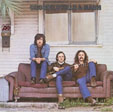
Crosby, Stills & Nash (1969)These days some modern music journalists are taking a revisionist view of this landmark album. Some say it was a fluke--the one relevant contribution from an ordinarily banal cluster of hippie musicians. Others discount it as obsolete, a relic of an anarchic period in our nation's history. Still others judge the album based on subsequent output from each of its members and the sometimes carnivalesque news stories covering substance abuse problems through the years. I believe wholeheartedly that these naysayers are wrong and here's why. Dynamic Vocal Style. The chronology of how this trio came together is well told and not necessary to recount. What's important is the sound they were inventing with three voices and a couple of acoustic guitars. First, unlike the approach of 60s folk music ensembles, or vocal groups like the Byrds or the Hollies, CSN typically blended their voices by singing with equal intensity (or delicacy), so that each voice, whether covering the melody, higher or lower harmony, blended with the others. As such, the listener can't always discern the melody--then discovers that it doesn't really matter. The effect is akin to having three melodies going at once, each deftly swirling in and out of the others. Only after hearing Stills' lone voice on the Suite Judy Blue Eyes demo from Stills' Just Roll Tape CD was I able to finally say, "Oh, THAT's the melody!" Ano
Additionally, CSN's singing technique included very effective use of dynamics; the three voices would swell with intensity and volume to emphasize an emotional point in the lyric, then drop back down effortlessly. One need only listen to CSN's contemporaries to hear how the trio's vocal style influenced them. You hear this influence in Yes (Roundabout, I've Seen All Good People), The Who (Behind Blue Eyes), America (Sandman, Horse with No Name), Jackson Browne (Doctor My Eyes), the Eagles (Already Gone, Peaceful Easy Feelin'), and so many others. Instrumentation. The first CSN record is also remarkable and trend setting in its abundant use of acoustic guitars, often de-tuned from conventional E-A-D-G-B-E tunings to Stills' Eastern tuning (E-E-E-E-B-E) or other variations. This results in a very rich, spacious quality in the guitars' resonance. Suite: Judy Blue Eyes, so recognizable by its opening riff, is performed in this Eastern tuning. Jimmy Page has said he was heavily influenced by CSN's use of acoustic guitars and modal tuning, which is evident in songs like Zeppelin's Babe, I'm Gonna Leave You, Going to California, Ramble On, among others. During the recording of this landmark album, Stills earned the name Captain Manyhands--alluding to his talent for playing acoustic and electric guitar, bass, piano, and organ on the album. Wooden Ships is a fine example of Stills' electric guitar style. From the muted reverb-drenched string count-off, to the bluesy meanderings beneath Stephen's and David's vocal dialog, to the wailing guitar solo, Stills exhibits enormous skill and taste executing guitar lines that musicians would copy for years to come. Before volume got the better of him, Stills could also get really sweet guitar tone, as evidenced by the lead fills throughout 49 Bye Byes. And his Hammond organ embellishments pay tribute to both Nashville and Motown. Finally, Stills' bass technique--always anticipating the "1" beat--gives a solid bottom end to the record. The Songs. Clearly the most striking thing about CSN's debut is the consistent quality of the songs. Marrakesh Express bounces along like a steam locomotive winding through an exotic landscape. Nash's imagery is whimsical to say the least:
Guinnevere is one of the most delicate and haunting songs to appear on any album from the 60s. With Crosby's beautiful guitar accompaniment (also in modal tuning--E-B-D-G-A-D), and Nash's vocal counterpoint, the song floats through the ether of a dream. But it's Stills' contributions that most define this album. You Don't Have to Cry expresses the contrast between Stills' escape from the establishment and a lover who still clings to the business world. Helplessly Hoping--a clever experiment in alliteration--describes a surreal world as quirky as Alice's Adventures in Wonderland. Here Stills uses a guitar technique called Travis picking, a finger-picking style characterized by an alternating bass line played with the thumb and the notes of a broken chord played with the first three fingers. In his hands, the sound is warm, relaxed, and perfectly articulated. And Wooden Ships--co-written with Crosby and Paul Kantner of Jefferson Airplane--conjurs up images of masted warships escaping from the aftermath of a sea battle. (Cannibas was most likely involved in the genesis of this song.) Finally, you can not talk about this landmark record without acknowledging Stephen Stills' amazing arrangement and production skills. Not unlike Lindsey Buckingham's subsequent influence on the sound of the mid-Seventies lineup of Fleetwood Mac, Stills becomes a master interpreter of Nash and Crosby's songs, augmenting them with thoughtful and carefully nuanced arrangements. Crosby's lovely acoustic guitar part on Guinnevere is made all the more haunting by Stills' delicate finger-picked electric accompaniment. Similarly, Nash's lighthearted Marrakesh Express is made all the more lively through Stills' staccato organ chords and layered effect-laden guitar fills. For Stills, as for his bandmates, CSN is the pinnacle of 60s folk-rock, and it is highly relevant in the context of its musical expression, songcraft, and execution. True, it is a product of its time--a tumultuous period of conflict between young and old, rich and poor, black and white, peace and war--but I believe it transcends that time and still sounds fresh and hypnotic as it did almost 40 years hence.
|
 ther factor adding to the cathedral blend of CSN was the timbre of each singer's voice. Crosby had the soulful, ultra-smooth voice, capable of singing almost in a whisper, as he does in Guinnevere, or exploding with rage as in Long Time Gone. Nash, dubbed razor throat by his band mates, generally took the high parts as he was capable of cutting through the mix of voices and electric instruments. Nash's voice was also tinged with his British accent, which added great color to the CSN sound. But it was Stills' voice--equal parts rock and roll and blue-eyed soul, with more than a hint of Texas twang--that gives the power to CSN's debut album. Stills also had a killer falsetto, which is evident in the second section of the Judy Blue Eyes suite:
ther factor adding to the cathedral blend of CSN was the timbre of each singer's voice. Crosby had the soulful, ultra-smooth voice, capable of singing almost in a whisper, as he does in Guinnevere, or exploding with rage as in Long Time Gone. Nash, dubbed razor throat by his band mates, generally took the high parts as he was capable of cutting through the mix of voices and electric instruments. Nash's voice was also tinged with his British accent, which added great color to the CSN sound. But it was Stills' voice--equal parts rock and roll and blue-eyed soul, with more than a hint of Texas twang--that gives the power to CSN's debut album. Stills also had a killer falsetto, which is evident in the second section of the Judy Blue Eyes suite: